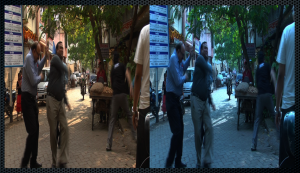Archive for July, 2011
 Seeing Red in 3D Quality Control
Seeing Red in 3D Quality Control

Comfortable 3D viewing requires matching left and right eye photography. The QC session can help identify obvious faults.
I recently spent a morning at Technicolor’s 3D quality control lab in Glendale CA and was extremely impressed with the sophistication of the QC teams and the review process. Graphical software developed by Technicolor enables the QC operator to accurately assess hyper-divergent and hyper-convergent scenes. No remedial action is performed at this point; the process is solely intended for informational purposes, to alert the filmmaker of potential problems that might impact the viewer’s comfort and overall experience.
Only four pixels of vertical disparity will pass muster in the QC suite so left and right cameras with even the slightest mismatched geometry are readily identified. Color discrapancies and synchronization issues affecting the left and right eye are also easily spotted and flagged. Truth is, under this level of scrutiny, virtually every 3D project ever produced, regardless of budget, will return a bevy of red trouble flags.
The filmmaker’s challenge then is to somehow separate the redness of the QC report from his or her legitimate storytelling goals. The creative requirements of visual storytelling in the third dimension necessarily precludes following too closely the dicates of the QC session. Producers may look upon the report’s red areas, a hyperdiverged background, for instance, in the corner of a scene, and lambaste the stereographer, director and DP, but is this “fault” so identified in the QC report really a defect that will detract from the viewing experience?
Let’s keep in mind that story above all must drive the technology, not the other way around. Audiences do not determine their like or dislike for a 3D program based on the green versus red ratio in a QC report. Yes, the report can be extremely useful to identify clearly disturbing 3D conditions, but it should serve as gospel to compel changes in the storytellers’ creative choices.